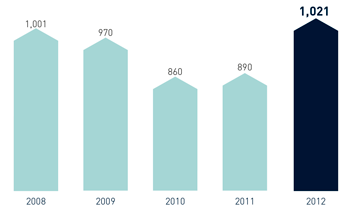Energy consumption
Overall energy consumption of Inditex Group facilities, expressed in Terajoules (TJ), comes from the use of fossil fuels (natural gas, propane and diesel) and electricity from the grid. It includes energy consumption from all factories, head office, chain head offices, logistics centres and stores. It does not include diesel consumption pertaining to logistics activities carried out by external operators (scope 3). The scope of the indicators includes Inditex’s own premises in Spain and all the stores owned by the Group worldwide.
Overall energy consumption (TJ)*
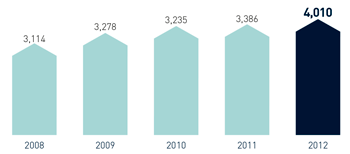
Overall natural gas consumption (toe)*

El incremento en el consumo de gas natural en 2012 respecto a años anteriores y la disminución del consumo de gasóleo se debe principalmente al cambio de varias calderas de gasóleo a gas natural, a la eliminación de los tanques de GLP existentes y a la apertura del edificio de oficinas y centro logístico de Massimo Dutti.
Overall diesel consumption (toe) *) **)
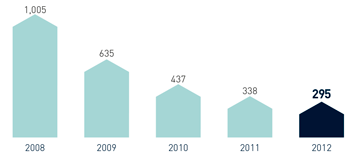
In head offices and factories
The energy consumption scheme permits the combination of different energy sources including renewable energies. Tri-generation plants consisting of heating and process boilers, solar panels and wind generators now make up more than 50% of the energy provided at the central office and factories.
In head offices and factories (kWh)

Natural gas consumption (toe) *) **)

Diesel consumption (toe) *) **)
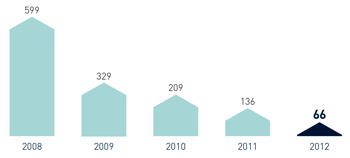
The increase in natural gas consumption in 2012 over previous years and the decrease in diesel consumption is mainly due to switching several boilers from diesel to natural gas.
Logistics and transport centres
All the garments manufactured by Inditex are distributed from the logistics centres in Spain. During recent years, Inditex has increased automation for distribution operations at the logistic centres. Consequently, there has been an increase in electricity consumed per garment released on the market (Wh/garment). In order to progress in the objective of reducing green house gases per garment compared to 2005, energy efficiency initiatives for logistics centres will be implemented in logistics centres as part of the 2011-15 Strategic Plan.
Natural gas consumption (toe)*

Diesel consumption (toe)*) **)

The increase in natural gas consumption in 2012 over previous years is mainly due to the opening of the Massimo Dutti office building and logistics centre.
* 1 tonne of oil equivalent (toe) = 41.868 GJ 103 m3 of Gas Natural = 0.9315 toe 1 tonne of diesel = 1.035 toe ** The overall diesel consumption, expressed as toe, has been updated for all the years to consider the density of diesel at 15 ºC as 0.832 kg/litre. Source: European Commission, Joint Research Centre, 2007.Stores
Electricity consumption at stores is without doubt very significant, hence a great deal of effort has been made to continue improving the eco-efficient store model. The objective is to achieve a reduction in electricity consumption per garment of 20% before 2020. This year, due to the adverse weather conditions and the work of refurbishing existing stores, the relative consumption in Wh per garment increased 14.69% over the previous year, and 1.97% over the level five years ago.
Electrical consumption in stores (kWh)*
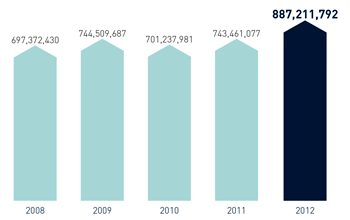
Relative electricity consumption by Wh/garment
